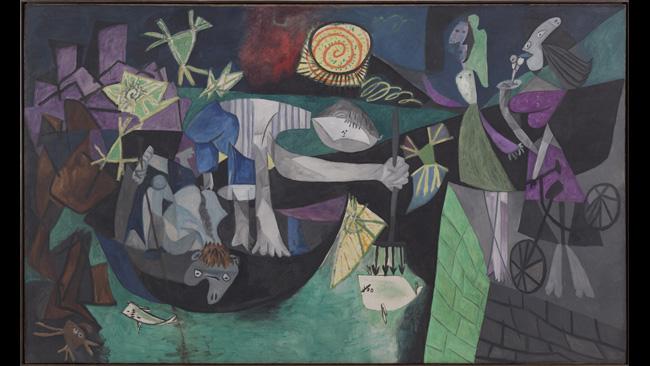Modern masters do their block at the Art Gallery of Western Australia
THE Art Gallery of Western Australia's present loan exhibition is a good example of a properly thought-out exhibition.

A BLOCKBUSTER was originally a bomb, then the term was used for films with mass appeal and, more recently, we have spoken of blockbuster exhibitions.
The idea is to put on something with such scale and impact that it rises above the noise of the media and the competing claims of other forms of entertainment, and draws crowds - especially new crowds - into museums and galleries. Politicians love to hear that large numbers of people have attended blockbuster exhibitions and, mostly, have no idea whether the show is any good.
From the point of view of the visitor, blockbusters can be a very unpleasant experience. You feel you should go but there can be a long and dispiriting wait in a queue and, once inside, you jostle with crowds pressing around each item. It's particularly annoying when many of the individual works could be viewed on any other day of the year in their home museum at one's leisure with hardly anyone in the vicinity.
It can be worth it, despite all, when the exhibition brings works together into a truly new and enlightening configuration - generally in the form of a monographic show on an individual or the survey of a period, movement or theme in art history. An outstanding recent example was Leonardo da Vinci: Painter at the Court of Milan exhibition at the National Gallery in London (2011-12); a few years ago another exceptional show, crossing historical periods, was Manet/Velazquez: The French Taste for Spanish Painting, at the Musee d'Orsay in Paris and the Metropolitan in New York (2002-03).
These are art-history-making exhibitions, which not only assemble great works but support them with essays by the best art historians and specialists in the relevant fields, in catalogues that become authoritative reference books. And this is the sort of thing that is very hard for us to achieve in Australia because none of our museums is significant enough to enter into the kind of partnerships between giant institutions that underpin these projects.
We have a very limited ability to initiate internationally significant exhibitions, although a partial exception to this was Ruth Pullin's Eugene von Guerard: Nature Revealed, which opened at the National Gallery of Victoria last year and has since travelled, in slightly reduced form, to Brisbane and Canberra. This exhibition, allowing us for the first time to understand the artist's early years in Germany and Naples through a judicious selection of international loans, showed him to be not only a great Australian artist but a figure of wider significance in the history of 19th-century art.
All too often, however, what a blockbuster means in Australia is a large, poorly selected and ill-digested collection of works, sometimes from an overseas museum that is temporarily closed for renovations. Aware of how hard it is to persuade foreign institutions to send their precious pictures to the ends of the earth, I have often been reluctant to criticise these shows too harshly, but recent experience has convinced me that we need to try a bit harder.
I observed a couple of years ago that the European Masters show from the Staedel in Frankfurt - the NGV's Melbourne Winter Masterpieces show for 2010 - was lacking in curatorial shape. In fact it was a disparate assemblage of material that might have composed four or five exhibitions. More recent Melbourne blockbusters such as Vienna: Art and Design (2011) and the present Napoleon exhibition seem unsure whether they are dealing with art, craft or history.
In Sydney, we had the colossal Picasso show in which less would certainly have been more. In Brisbane, the very disappointing Modern Woman exhibitions of drawings from the Musee d'Orsay was apparently a pale version of the exhibition of the same name previously shown in Vancouver, while the present exhibition from the Prado, as I pointed out a few weeks ago, contains some very fine pictures but has no overall focus.
There are two tests for a good exhibition: quality and coherence. Ideally, all the works in a show should be outstanding examples of their kind, and it is better to have fewer pieces, but of higher quality, than fill rooms with mediocre works that distract the viewer from the better ones. The imperative of quality is particularly important if the show has no other rationale than to be masterpieces of this or that.
If the exhibition does have a proper rationale, though, it is a bit different. The story can be told around a few outstanding pieces, supported by more minor ones. This is an approach we should consider in Australia, since it would allow us to make the most of our limited ability to secure loans of really great works. The Prado exhibition could have been much stronger if focused on the portrait, for example or on religious imagery, both dominant themes in Spanish art.
The Art Gallery of Western Australia's present loan exhibition from the Museum of Modern Art in New York is a good example of a properly thought-out exhibition, and in many ways also a model that other galleries should consider. All the works are of a high standard, the curatorial structure is simple and straightforward, and the overall experience, as a result, is pleasurable and enlightening.
Picasso to Warhol is presented as an anthology of 14 modern artists, almost all of whom are undeniably central to the story of modernism during the first two-thirds of the 20th century.
Each artist is represented by a group of works, so that we are able to enter into a particular sensibility and understand something of its evolution.
The works could indeed have been displayed chronologically, divided according to the three or four great phases of modernism: the initial explosion of invention before World War I; the inter-war years (which can be further broken down into the years before and after 1929); and the years after World War II. But with such very different artistic personalities, the mini-monographic approach is probably more effective.
The sequence on Piet Mondrian is a model of clarity: we start with an early landscape, a beautiful little picture that is imbued with the tradition of Dutch painting in its use of tone and colour as well as its subject, but which already reveals the artist's attraction to the horizontals and verticals that will come to dominate his mature work. We pass from this to a more minimal landscape in an entirely different palette, then to early geometric abstractions and finally to the black grids and squares of primary colours of his later work.
Giorgio de Chirico is also well represented by three important pictures, which end up as one of the most memorable parts of the exhibition, although in his case they all date from immediately before World War I. The earliest of them, The Nostalgia of the Infinite (c 1912-13) is dominated by a vast tower that suggests some ancient monument such as the lighthouse of Alexandria, but for the pennants that flutter on top and evoke an Edwardian bathing resort such as the Lido at Venice. Two tiny men converse in the centre, with long afternoon shadows trailing behind them, while the foreground is darkened by the shadow of a monumental arcade.
Nostalgia is etymologically a longing for homecoming, and the other works also hint at a poignant contradiction between longing for the infinite and the circumscribed realities of modern life. The Song of Love (1914) juxtaposes the head of the Apollo Belvedere with a rubber glove - not then an object of domestic use but evoking industrial or surgical applications. The arches on the right of this picture and the train in the background both reappear in The Enigma of a Day (1914), which once belonged to Andre Breton, as do the two human figures with their long shadows. The whole composition is dominated by two looming industrial chimneys and one of those statues of 19th-century worthies ubiquitous in Italy since the unification.
Alexander Calder is one of the delightful surprises of the exhibition, again well-represented with beautiful and meditative works that seek to remake nature through artifice. At almost the opposite extreme of sensibility, there are objects and a silent film by Marcel Duchamp - hypnotic optical effects alternating with his characteristic puns, anagrams and other wordplay - and one of the boxes that he produced as an edition, containing miniature versions of his complete oeuvre.
Film is a prominent part of two other sequences. One is by Fernand Leger, an interesting but relatively secondary painter who seems to run out of steam after a promising start. His short silent film Ballet Mecanique (1924), however, is of great interest and also includes some animation sequences that strikingly anticipate those of William Kentridge.
The other film is by Andy Warhol, otherwise well represented by soup cans, stencilled boxes and a series of screenprint self-portraits in which we see how things can be both superficially different and fundamentally interchangeable in the consumer world; Screen tests is a selection from 472 animated portrait shots of visitors to the Factory, as his studio was called, in the years 1964-66. Each take was a little under three minutes, the length of a spool of film, but they are slowed down in projection to a little more than four minutes. The result is not obvious slow-motion - and the figures are mostly sitting still in any case - but an uncanny and dreamlike effect of alienation.
Among the other modern masters, Matisse is represented with sculptures as well as a series of lyrically decorative pictures in which he makes the most of complementary colours - red goldfish swimming in green water - as well as a luxuriance of natural and artificial pattern.
The Picasso selection is a strong one and offers an effective idea of the artist compared with the massive exhibition mentioned earlier. It starts with an extraordinary early self-portrait, balanced between an almost alarming expression of the will that characterised the artist throughout his career and an absent gaze in the eyes as they search into the depth of the mirror.
We see the moment at which he and Braque began to conceive of analytical cubism after seeing the great Cezanne retrospective in 1907 that followed the artist's death in 1906, and then the maturing style a couple of years later. But the section is dominated by the extraordinary Night Fishing at Antibes (1939), a work that epitomises so many of the complexities of the artist, in its decorative modernist distortions held together by a grasp of figural composition grounded in Raphael. At the same time it reminds us of the fate of modernism, evolving between the catastrophes of history: for that carefree summer in Antibes would be followed, in September, by the outbreak of World War II.
Picasso to Warhol: Fourteen Modern Masters
Art Gallery of Western Australia, Perth, until December 3



